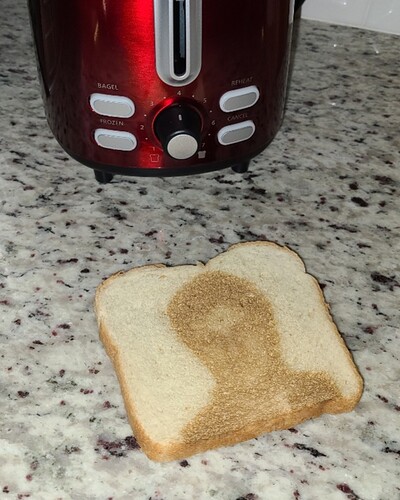Saw this, just had to share, but like seriously seriously DO NOT TRY THIS!!!
I mean, do what you want! But I’ll warn you all we once tried to decorate some sugar cookies with the laser and the designs came out kind of cute but the cookies tasted like… the laser cutter. Like, that weird metallic industrial smell? It just PERMEATED. It was incredible, in an awful way. Even the parts of the cookie that you’d think were untouched, somehow tasted like you were licking the bed of the laser cutter. It’s been a few years but it was memorable enough that nobody’s tried a food thing since.
I think I read that glowforge shows people making designs on pumpkin pies, etc on their lasers but when you read their fine print they say if you have a laser for food, never cut anything else on it. keep your food laser separated from your everything else laser.
Well, I’m glad I wasn’t around back then to experience that…
So is it something special for cutting food or does the residue from other stuff somehow end up in the food? I am having trouble imagining that a laser itself can impart any unique flavor of its own on something.
Oh I laughed so hard reading that.
…no, untoasting is not a thing. I answer without looking up the names of the chemical reactions, becauae I knew the “class” of the reactions. And they are a mixed bag, some … many of which are NOT classified as reversible reactions. Once you have broken carbon-carbon chains, you can only put them back together… in some miraculous pathways. Meaning… they dont go back together.
The generalized pov is this;
The main reaction utilized to string carbon atoms into a chain, usually 6 carbon sugars, is photosynthesis. Even oils from bio-sources, were once sugar molecules, then … cleaned up.
Beyond that, Friedels-Crafts synthesis can hook carbon chains together, but only particular types, and only in hot, solvated, pressurized reactors.
Hey, you asked.
Far more detailed answer available upon request. Beer required.
I can give a few hours of exposition on a long explanation. If you ever want it.
The short one is… the freshly cut starch or cellulose chains [bread] or cardboard are “activated” by the high energy laser light, into highly activated radicals that can quickly mop up tiny concentrations of charred condensate that has been condensed onto the inside of the laser cutter chamber. It doesnt have to have a lot of smoke condensed on the inside. It just needs to have a strong “pull” by the energized radicals on the surface of the cut toast, in and near the cut surface. And the highly porous bread matrix is an effective smoke sponge.
Add to that, the eating experience chewing mechanics where the semi-volatile surface gases [smoke] is more easily released into the mouth, than anything else, catalyzed by the wetting of saliva. Inducing the release of absorbed gases. The sense of smell dominates in the early phase of chewing. As gases [smoke] are released by wetting and chewing pressure. The rest of flavor and aroma are not driven by radical chemistry, and are easily overwhelmed. You just dont notice the rest of toast flavor and aroma. They are too subtle in comparison to activated smoke.
Surface chemistry mostly… still , complicated coz so much of it is multiple invisible steps of absorbtion/desorbtion. And if a laser is involved, a mix of superfast and then some slow steps afterward. All in all, mostly a cascade of gas generation, absorbtion, and later desorptions.
The longer explanation breaks each of these steps into smaller steps.
(We didnt lasercut toast at Boeing. Mostly epoxy and urethane films. But fine tuning a laser, its pulse width, and trying to control the surface temperature is what we did. Ablation is a different step [energy level] than just scoring. But we did both. And sometimes had to fiddlle with the laser, and not just goniometers or transit heads. Later, at ORI, I advised on cutting human tissues… and plasma stuff. And yet, there is still more, much more for me to learn on this topic. I mean, most folks I see running our machines are [pragmatically] more skilled than m’self. And Im glad to know them all. ]
So he didn’t untoast bread, he hydrated toast… talk about clickbait


